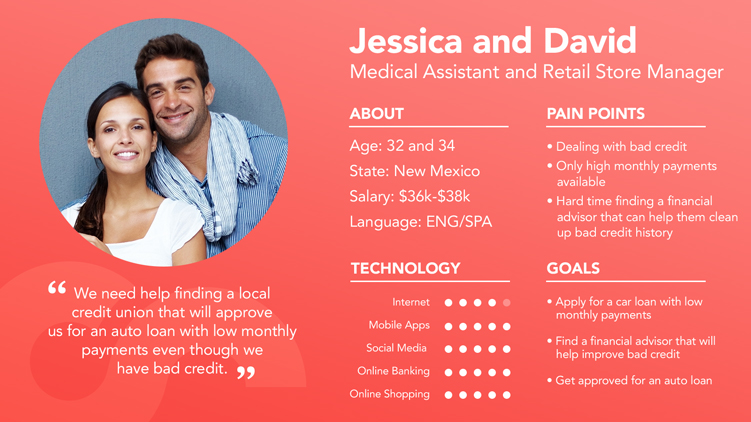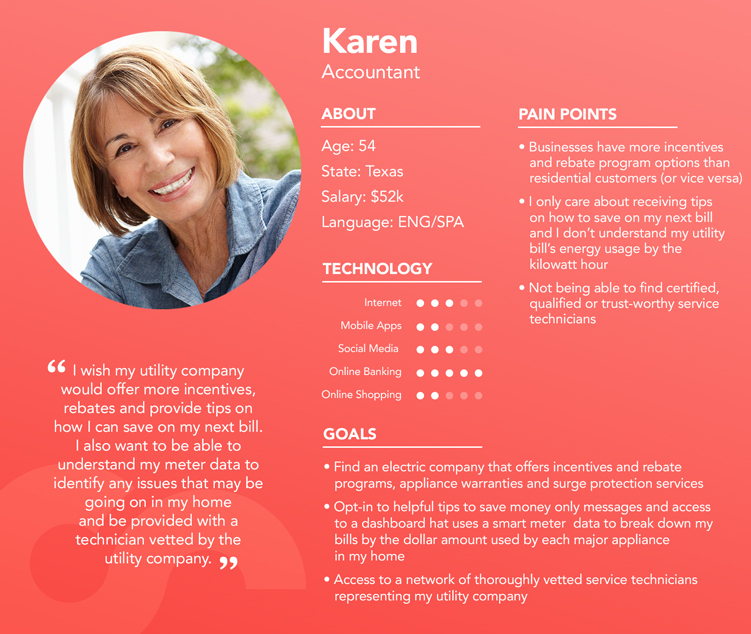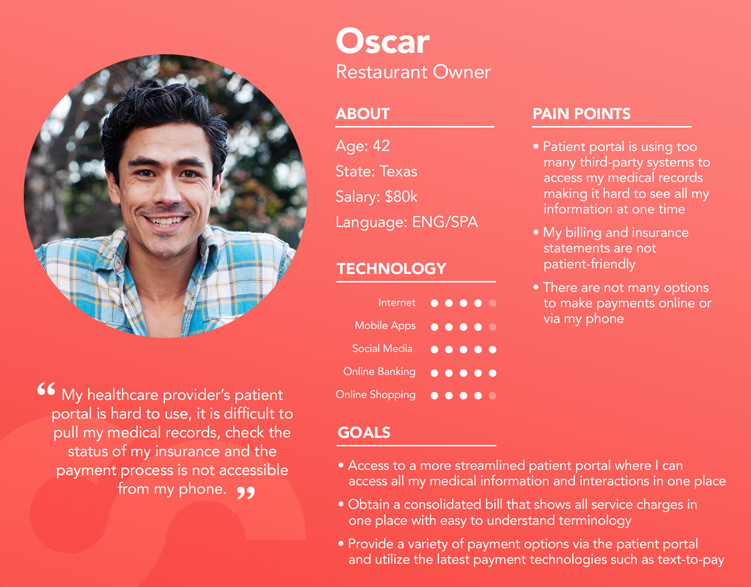
The Power of Personas:
A Brief Guide, Part 2
In collaboration with Perla Parra
Welcome back! In my previous article The Power of Personas: A Brief Guide Part 1, we covered research and persona information-gathering techniques as well as identifying your persona pain points and challenges. Now we can move forward on the information breakdown and why this information is so critical when considering how to best set-up any marketing campaign to ensure the highest level of engagement and generating leads.
ANALYZING YOUR DISCOVERIES
After some extensive audience research, it’s time to analyze and condense your findings. Take a closer look at your data and see if you can identify patterns in your audience’s responses or behaviors. Once you start noticing any overarching emotional responses, the next step is to channel them into your marketing. Understand that people don’t expect products or services to fix their needs, but to answer three important questions: What challenge does this person have that will cause them to need you? What value or solution do you provide to their challenges? Why are you their best option?
Understand How Your Brand Can Help
Now that you have a better understanding of your customers’ pain points and goals, you are speaking to a defined audience and can create a clear picture of how your products and services can help. This is a little tricky, as you’ll need to flip your thinking and consider your products and services from a buyer’s point of view.
This is the time to ask yourself the three most important questions for each of the pain points and goals you’ve collected. The answers will provide the basis for the key marketing messages your persona will help you address.
CREATING YOUR PERSONA
After you’ve finished with the psychographic data and responses, start looking for common characteristics. As you group these characteristics together, you’ll have the basis of your unique persona. Defining the audience by who they are, and the specific interest and challenges that they have, is critical to the success of any content marketing plan.
Here’s how this looks in practice. Let’s say you identify a core customer group of women in their early 30s who live in mid-sized cities, love boxing training, and own a parrot. Great — now it’s time to take this abstract collection of characteristics and turn them into a persona that you can identify with and speak to.
Give your buyer persona a name, a job title, a home, and other defining characteristics. You want your persona to seem lifelike without getting way too specific or excluding characteristics that should rightly be considered part of this customer group.
Think of this as if you’re filling out a profile on a dating website for a friend who desperately needs a date. In other words, aim for about the amount of information you’d expect to see on a dating site, or what you might learn from a short conversation on an airplane or at a bus stop. Pain points and goals are a must.
For example, your group of boxing, urban, female parrot owners could be represented by the persona you name Boxing Beth. Rather than speaking generally about training for boxing and parrot ownership, you’ll give Beth representative characteristics that make her a real person:
- She is 32 years old
- She lives in Oakland
- She works at an accounting firm
- She owns a five-year old cockatiel named Sam
- She likes boxing training at a King’s Boxing Gym
And so on.
Remember, a list of characteristics does not equal a persona. Your persona should be a realistic description of a person who represents one segment of your customer base. Sure, not everyone in this customer group will match the characteristics of your persona down to a T. Your persona, however, represents this customer group to you and allows you to think about them in a human way rather than as a collection of data points.
It’s a lot easier to speak to Beth than it is to speak to “women.” Or even “32-year-old women who own cockatiels.”
As you flesh out your persona, be sure to describe both who your persona is now and who they want to be. This allows you to start thinking about how your products and services can help them get to that place of ambition.
In a nutshell, your persona’s profile should at least contain:
- Photo — To emphasize age and demographics
- Name — To give it a human element
- Occupation/Background — Job, interests, etc.
- About/Demographics — Gender, age, income, location, etc.
- Goals — What do they want? What makes the tick?
- Pain points — What’s keeping them from fulfilling their goals?
- Technology — How can you use technology to help your persona achieve their goals and overcome challenges?
- Real quotes — Something they would say about their challenges or goals.
B2C Persona Examples in The Following Industries:

Financial Customer Persona Example
- Quote — “We need help finding a local credit union that will approve us for an auto loan with low monthly payments even though we have bad credit.”
- Name — Jessica and David
- Occupation – Medical Assistant and Retail Store Manager
- About — 32 and 34 years old, from New Mexico, salary $36k-$38k, Bilingual
- Technology — very active on social media, mobile apps and online banking
- Pain Points —
- Dealing with bad credit
- Only high monthly payments available
- Hard time finding a financial advisor that can help them clean up bad credit history
- Goals —
- Apply for a car loan with low monthly payments
- Find a financial advisor that will help improve bad credit
- Get approved for an auto loan

Utility Customer Persona Example
- Quote — “I wish my utility company would offer more incentives, rebates and provide tips on how I can save on my next bill. I also want to be able to understand my meter data to identify any issues that may be going on in my home and be provided with a technician vetted by the utility company.”
- Name — Karen
- Occupation — Accountant
- About — 54 years old, from Texas, salary $52k, Bilingual
- Technology — Internet, Mobile Apps, Social Media, Online Payments
- Pain Points —
- Businesses have more incentives and rebate program options than residential customers (or vice versa)
- I only care about receiving tips on how to save on my next bill and I don’t understand my utility bill’s energy usage by the kilowatt hour
- Not being able to find certified, qualified or trust-worthy service technicians
- Goals —
- Find an electric company that offers incentives and rebate programs, appliance warranties and surge protection services
- Opt-in to helpful tips to save money only messages and access to a dashboard that uses a smart meter data to break down my bills by the dollar amount used by each major appliance in my home
- Access to a network of thoroughly vetted service technicians representing my utility company

Healthcare Customer Persona Example
- Quote — “My healthcare provider’s patient portal is hard to use, it is difficult to pull my medical records, check the status of my insurance and the payment process is not accessible from my phone.”
- Name — Oscar
- Occupation — Restaurant Owner
- About — 42 years old, from Texas, salary $80k, Bilingual
- Technology — Internet, Mobile Apps, Social Media, Online Payments
- Pain Points —
- Patient portal is using too many third-party systems to access my medical records making it hard to see all my information at one time
- My billing and insurance statements are not patient-friendly
- There are not many options to make payments online or via my phone
- Goals —
- Access to a more streamlined patient portal where I can access all my medical information and interactions in one place
- Obtain a consolidated bill that shows all service charges in one place with easy to understand terminology
- Provide a variety of payment options via the patient portal and utilize the latest payment technologies such as text-to-pay
PUTTING YOUR PERSONA TO WORK
Buyer personas allow you to craft effective, targeted messages that speak directly to an audience or customer group that you’re trying to reach.
Think about how we communicate in our personal life. We usually share important messages differently depending on who we want to reach, right? Include terminology that you would use in your SEO strategy, key terms that will attract your personas in email communications, subject lines, articles, social media, etc.
Say you have interesting news to share with your parents, friends, and coworkers. You probably use different words and tools to speak with each of them. You might call your sweet ol’ mom on the phone, post on Slack to notify your colleagues, or use a messaging app to share with your friends.
By understanding your persona, you start to realize the best ways to reach your desired audience, just as you subconsciously know how to best reach and speak to different groups of people in your personal life.
CONCLUSION
If you think of your personas as actual people, you’ll be able to develop marketing messages that speak to and reach real people. Marketing tends to fall on buzzwords, and corporate mumbo jumbo doesn’t really mean anything. It’s harder to fall into that trap when you’re creating a message specifically for your persona.
What questions does your persona have that your marketing message can answer? What social networks are they using? What kind of language do they use when interacting online? How does your brand help this specific persona solve their problems and achieve their goals?
Viewing your persona as a real person ensures you address their priorities first and foremost. Keep them at top-of-mind every time you make a decision regarding your business and marketing strategy. Treat your personas right, and you’ll build a bond with the real audience they represent.
If your content strategy is stalling out, maybe it’s time to start thinking about developing your own buyer personas. Luckily for you, we’ve got a talented team that’s ready to take your marketing to the next level. Drop us a line or give us a call at (915) 581-7900 to get started!